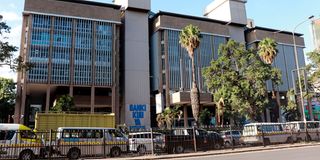Credit scores and why they hold the key to vibrant SMEs, job creation

The Central Bank of Kenya head office in Nairobi. The Central Bank Rate has risen from seven per cent in March, to 8.25 per cent now. To get loans to small business at under 10 per cent, one has to wrestle with this base.
What you need to know:
- Credit reference bureaus (CRBs) were created to make it easier for financiers to lend to the informal sector.
- The current debate, however, points to a misunderstanding and misuse of credit scores.
- A credit score is a number ranging from 200 to 900 that rates a customer’s creditworthiness.
Loans for individuals, micro and small businesses are key to job creation.
The informal sector creates about 80 per cent of all new jobs in Kenya every year.
Credit reference bureaus (CRBs) were created to make it easier for financiers to lend to this sector.
The current debate, however, points to a misunderstanding and misuse of credit scores.
A credit score is a number ranging from 200 to 900 that rates a customer’s creditworthiness.
The higher the score, the better. It is developed from one’s accounts, levels of debt, repayment history and so on. In many countries, it includes consumer credit data.
Unfortunately, the Kenyan model is restricted to data from the regulated financial market, which leaves out vital information such as from the water and power firms, which would mostly improve our scores because, while only a few get bank loans, we all pay for water and electricity.
Lenders use the score to evaluate the possibility that you will repay your loan in a timely manner. Put differently, what is the probability that you will default? So how do we stack up?
Of 19 million files on individuals in the database of a leading CRB, only 17.04 per cent have less than satisfactory credit quality.
These are scores below 500. The rest, 82.96 per cent, have satisfactory or better credit quality.
Among 600,000 companies in the same database, only 3.86 per cent have less than satisfactory credit quality. The perception that Kenyans generally have poor credit quality is misplaced.
One-person outfits
Most micros are unregistered, one-person outfits and the credit quality of the owner is the same as that of their micro.
And 77.11 per cent of all individuals have moderate, good, and very good credit quality, the majority (63.02 per cent) being the good credit category rank – the second highest in the scale.
Credit scoring also gives lenders the tools to accurately estimate risk. This is what the banking regulator has directed that banks must do.
Our risk profiles differ from one small business to another. We are in different sectors and operate in different locations.
Some are new while others have been around for a while. Obviously, when the banks lend to all of us at 13.5 per cent, it is wrongly assumed that we have the exact same risk profile.
But by accurately estimating the expected loss of each of the loans, the lenders can price our individual loans to reflect that.
Sadly, even though the Central Bank has approved the risk pricing models of more than 23 banks, I am yet to hear of any that are actually using the models to price individual loans.
Social media has been awash with details of the high rates we are paying to lenders of micro loans. The regulator should put the various loan prices in one accessible space.
Finally, the base is the Central Bank Rate. This has risen from seven per cent in March, to 8.25 per cent now. To get loans to small business at under 10 per cent, one has to wrestle with this base.
@NdirituMuriithi is an economist





